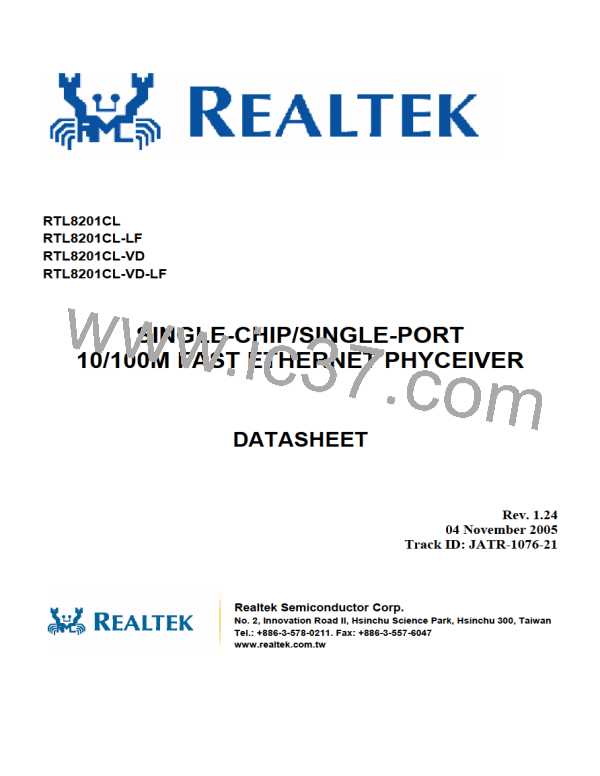RTL8201CL
Datasheet
7. Functional Description
The RTL8201CL PHYceiver is a physical layer device that integrates 10Base-T and
100Base-TX/100Base-FX functions, and some extra power management features into a 48-pin single chip
that is used in 10/100 Fast Ethernet applications. This device supports the following functions:
• MII interface with MDC/MDIO SMI management interface to communicate with MAC
• IEEE 802.3u clause 28 Auto-Negotiation ability
• Flow control ability support to cooperate with MAC
• Speed, duplex, auto-negotiation ability configurable by hard wire or MDC/MDIO
• Flexible LED configuration
• 7-wire SNI (Serial Network Interface) support (only in 10Mbps mode)
• Power Down mode support
• 4B/5B transform
• Scrambling/De-scrambling
• NRZ to NRZI, NRZI to MLT-3
• Manchester Encode and Decode for 10Base-T operation
• Clock and Data recovery
• Adaptive Equalization
• Far End Fault Indication (FEFI) in fiber mode
7.1. MII and Management Interface
7.1.1. Data Transition
To set the RTL8201CL for MII mode operation, pull the MII/SNIB pin high and set the ANE, SPEED,
and DUPLEX pins.
The MII (Media Independent Interface) is an 18-signal interface (as described in IEEE 802.3u) supplying
a standard interface between the PHY and MAC layer. This interface operates at two frequencies –
25Mhz and 2.5Mhz to support 100Mbps/10Mbps bandwidth for both transmit and receive functions.
Transmission
The MAC asserts the TXEN signal. It then changes byte data into 4-bit nibbles and passes them to the
PHY via TXD[0..3]. The PHY will sample TXD[0..3] synchronously with TXC — the transmit clock
signal supplied by PHY – during the interval TXEN is asserted.
Reception
The PHY asserts the RXEN signal. It passes the received nibble data RXD[0..3] clocked by RXC. CRS
and COL signals are used for collision detection and handling.
In 100Base-TX mode, when the decoded signal in 5B is not IDLE, the CRS signal will assert. When 5B is
recognized as IDLE it will be de-asserted. In 10Base-T mode, CRS will assert when the 10M preamble
has been confirmed and will be de-asserted when the IDLE pattern has been confirmed.
Single-Chip/Port 10/100 Fast Ethernet PHYceiver
14
Track ID: JATR-1076-21 Rev. 1.24

 REALTEK [ Realtek Semiconductor Corp. ]
REALTEK [ Realtek Semiconductor Corp. ]